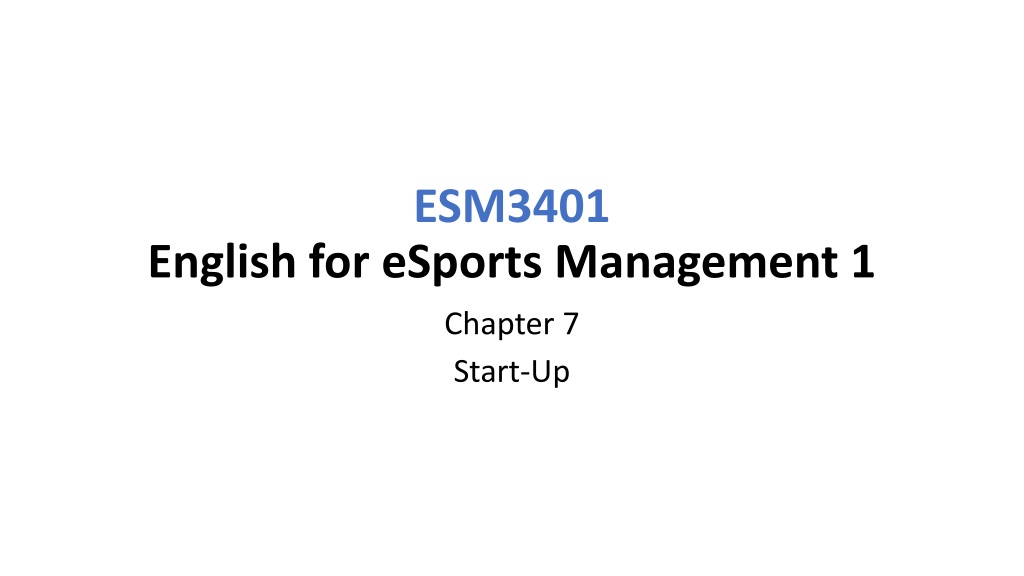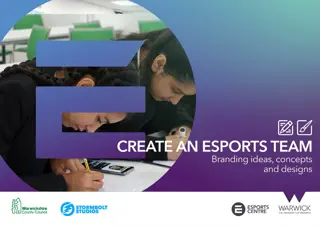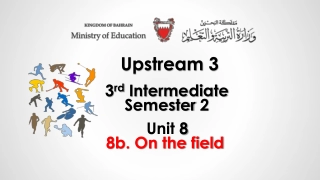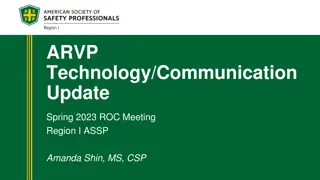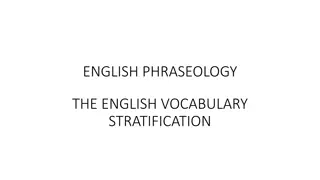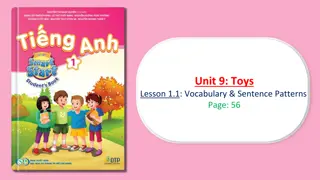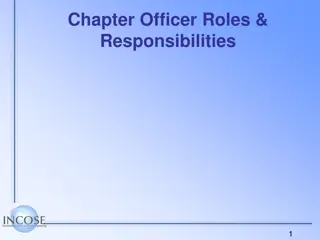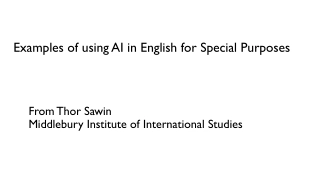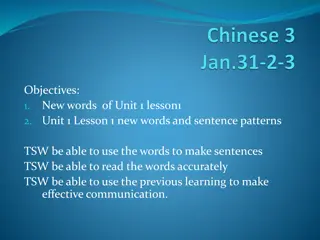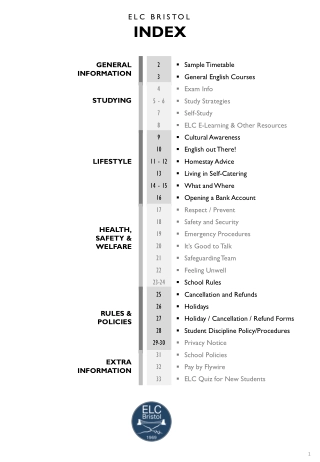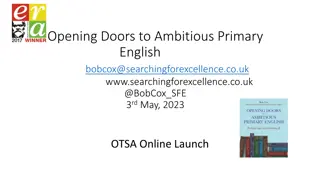ESM3401 English for eSports Management: Chapter 7 Start-Up Overview and Vocabulary
In this chapter of ESM3401, students delve into business correspondence, speaking, reading, writing, listening, and vocabulary related to eSports management start-ups. The content includes group assignments and team member details for engaging exercises. Key vocabulary terms such as Milestone, Project Budget, and Sprint are defined to enhance understanding of project management concepts.
Download Presentation
Please find below an Image/Link to download the presentation.
The content on the website is provided AS IS for your information and personal use only. It may not be sold, licensed, or shared on other websites without obtaining consent from the author. Download presentation by click this link. If you encounter any issues during the download, it is possible that the publisher has removed the file from their server.
Presentation Transcript
ESM3401 English for eSports Management 1 Chapter 7 Start-Up
OVERVIEW BUSINESS CORRESPONDE NCE SPEAKING READING WRITING LISTENING VOCABULARY
Group Assignement
Team Member Tuesday 63127349005 63127349019 63127349023 63127349027 63127349040 63127349008 63127349009 63127349010 63127349038 5 1 63127349030 63127349036 63127349012 63127349037 63127349014 63127349004 63127349031 63127349033 63127349039 6 2 63127349001 63127349002 63127349003 63127349024 63127349025 63127349020 63127349029 63127349034 63127349035 7 3 63127349013 63127349021 63127349022 63127349028 63127349058 63127349006 63127349011 63127349016 63127349017 8 4
Team Member Wednesday 63127349052 63127349054 63127349042 63127349074 63127349065 63127349041 63127349043 63127349048 63127349066 63127349070 63127349049 63127349051 63127349057 63127349067 63127349078 63127349030 63127349036 63127349012 63127349037 63127349014 63127349020 63127349029 63127349034 63127349035 63127349013 63127349021 63127349022 63127349028 63127349058 1 6 7 2 8 3
Vocabulary Milestone (N) : Major event in a project lifecycle. It is used as a reference point to measure the progress of a project. Project Budget (N) : Formally approved document featuring a comprehensive list of financial resources. Project Timeline (N) : Outlines the project events in order of their occurrence. It captures exactly what needs to be done over the course of the project lifecycle and how it will be done. Project Stakeholder (N) : Any individual that has a direct or indirect interest in a project. They usually affect or are affected by the project decisions being taken over the course of the project lifecycle. Collaboration (N) : The process of actively involving each team member in project activities. The whole concept demands the development of an interconnected network through which individuals exchange information and monitor the project performance.
Vocabulary Bottleneck (N) : Work stage where the inflow of workload is greater than the capacity of the system. Scrum (N) : The framework uses the iterative method of delivering projects and is based upon continuous systematic collaboration among team members in between the project cycle. Sprint (N) : A sprint is a fixed unit of time during which specific tasks has to be completed. Work Breakdown Structure (WBS) (N) : Comprehensively divides the project deliverables into manageable sections. This hierarchical organizing of the team s work helps everyone understand the nature of work better and execute project goals effectively. Work in Progress (WIP) (N) : At any point during a project, the number of task items a team is currently working on is called work in progress.
Start-Up Idea Team Building Project Idea Project Planing
Start-Up Idea The Value Proposition Canvas Value Map (Specifific Value Proposition) Product and Service (list of product and services your built around) Gain Creators (How your product and services create customer gain) Pain Relievers (How your product and service alleviate customer pains) Customer Profile (Cuctomer Segmentations) Customer Jobs (What customer are trying to get done in their works and lives) Gains (The outcomes customer want to achieve or concrete benefits) Pains (The bads outcomes, risks related to customer jobs)
Start-Up Idea The Value Proposition Canvas
Start-Up Idea The Value Proposition Canvas
Start-Up Process Start-up planning is a crucial stage that comes right after initiation in project management cycle. The cycle consists of four distinct phases: initiation, planning, execution and closure. Project Initiation : Quickly establish is worth pursuing Project Planning : Align on Goal, Timeline and Budget Project Monitoring : Successfully achieve goals outlined in planning Project Closure : Wrap up project and capture key learning
Components Project Management Activities Tasks Resources
Components Project Management Activities What are the things your team will need to do in order to get the project done? Tasks These are smaller jobs that make up the bigger picture of your project. Having incremental goals makes measuring success and addressing bottlenecks. Resources What are you working with? Your resources include your budget, of course. It s also important to understand your human and material resource requirements.
The Key Elements of Start-Up Planning
The Key Elements of Start-Up Planning Stakeholders Needs Stakeholders will include anyone affected by your project employees, clients, and project sponsors. Identify these stakeholders, meet with them, and prioritize their needs based on urgency and importance. Project Objectives Create the project objectives from the stakeholder s needs. These objectives should be specific, measurable, attainable, realistic and timely. Deliverables and Due Dates Your deliverables are the products or services you need to deliver. Each deliverable should include a timeline. Project Schedule Projects schedules specify the deliverables, tasks for each deliverable, the time frames for completing the tasks and who will complete them.
The Key Elements of Start-Up Planning Roles and Responsibilities Specify who oversees the projects, handles each deliverable and what client roles are. Defining roles ensures everyone understands what s expected of them. Project Costs Understanding project costs helps you allocate budgets and aids in identifying shortfalls early in the project. Communication Plan Your communication plan should detail how often you communicate with stakeholders, what type of communication they want and mention any project checkpoints that require client approval before proceeding. Tracking and Management tools How will you communicate with stakeholders? How will you deliver what your client wants?
Start-Up Planning Tools Grantt Chart
Listening Strategy Listening for only the big picture but not the details and trying to understand every single word speaker says. Top-down listening Bottom-up listening Uses Background Knowledge And Contextualizes Words To Aid Comprehension Uses Sounds, Words, And Other Small Units To Create Meaning.
Listening PRACTICE How to improve your BUSINESS COMMUNICATION? https://www.youtube.com/watch?v=SSgOiUNxlOA
Business Pitching Steps to create a winning pitch for your business. Time span The pitch should be clearly explained to the investors in a short time. You should know that you only have a few minutes to sell your business idea. Make your presentation realistic Presenting a realistic picture of the prospects of the business is preferred. You have been running the business with your own funds up until now, so you have had your share of successes and failures. Your projections must be based on those experiences and must sound realistic.
Business Pitching Savings Attitude One of the most important qualities of a startup founder is financial control. Understanding where every penny is being spent in the business will add to your brownie points. You have to make the investors know that you have a grip on the business and its operations. The Business Opportunity The most important aspect of pitching for your business is to highlight the business opportunity and how are you going to tap it. Understanding of the Competition In-depth competition analysis must be presented, and you must highlight how your product stands out and has better prospects, as compared to others.
Business Pitching Marketing strategy Knowing your marketing plan is another very important aspect of pitching your business. Your goal is to build a market for your products and services. The strategy has to be clearly explained to the investors, so they know how are you going to position the product in the market. Target Audience Being focused about your business and knowing who exactly you wish to sell to is important for the business. This lets you earn the investors confidence, so they know that you are going to reach out to a tangible audience and achieve the desired profitability. Focus The more focused your approach, the higher your chances will be of getting the desired amount of funding. In your pitch, you need to communicate the precise plan of action, and how you will use it to achieve the desired results. You also need to be specific about the amount of funding you require.
Business Pitching Create a multi-level pitch A multi-level pitch helps you divide the pitch into shorter and longer versions. The shorter versions help in explaining the basics. The longer version helps to explain the details and how the plan is going to be executed. Get your team to participate A business leader must always take his or her team along with them. This adds to the confidence of the audience. You should encourage team members to participate in the pitch process by planning out the speaking slots for them. A strong team showcases the ability of the business to grow and provide the desired return to the investors.
Reading Technique Speed Reading The aim of speed-reading is basically to increase the reading speed without compromising the understanding of the text reading. Some of the strategies used in speed reading are as follows: Identifying words without focusing on each letter; Not to sounding-out all words; Not sub-vocalizing some phrases; Spending less time on some phrases than others; Skimming small sections.
Reading Technique How to Improve Your Speed Reading : Knowing the "how" and "when" of speed reading is only the first step to success. Here are some more tips to help you Avoid distractions. Create an environment where there are as few interruptions and distractions as possible Go easy. Read an uncomplicated novel or a simple online article to get a feel for which technique is going to work best for you. Cover words that you've already read. This helps you to stop your eyes flitting back to earlier words and slowing down you're reading. Know what you want from the text. This can be useful if you are using the skimming method, as it primes you to pay attention. You can then slow down at these points, or circle them for emphasis, but otherwise move across the page quickly. Practice, practice, practice. You have to practice speed reading to get good at it.
Reading Technique http://www.readingsoft.com http://www.freereadingtest.com
WRITING INTRODUCTIONS Hooking The Reader Giving Background Information INTRODUCTI ON Presenting The Problem Statement Mapping Essay s Structure Checking And Revising
Writing Introductions Hook your reader Your first sentence sets the tone for the whole essay, so spend some time on writing an effective hook. The hook should lead the reader into your essay, giving a sense of the topic you re writing about and why it s interesting. Avoid overly broad claims or plain statements of fact. Give background information Next, give your reader the context they need to understand your topic and argument. Depending about your essay, this might include: Historical, geographical, or social context An outline of the debate you re addressing A summary of relevant theories or research about the topic Definitions of key terms
Writing Introductions Present your thesis statement Now it s time to narrow your focus and show exactly what you want to say about the topic. This is your thesis statement a sentence or two that sums up your overall argument.
Writing Introductions Map your essay s structure Particularly in longer essays, it s helpful to end the introduction by signposting what will be covered in each part. Keep it concise and give your reader a clear sense of the direction your argument will take. Check and revise As you research and write, your argument might change focus or direction as you learn more.
Writing Aim, Objective Research Aims A research aim describes the main goal or the overarching purpose of your research project. In doing so, it acts as a focal point for your research and provides your readers with clarity as to what your study is all about. Research Objectives Where a research aim specifies what your study will answer, research objectives specify how your study will answer. Research objective divide your research aim into several smaller parts, each of which represents a key section of your research project
Writing Aim Your aim should be made up of three parts that answer the below questions: Why is this research required? What is this research about? How are you going to do it?
Writing Objective Each of your research objectives should be SMART OBJECTIVE Specific : be precise about what you are going to do Measurable : you will know when you have reached your goal Achievable : Don t attempt too much a less ambitious but completed objective is better than an over- ambitious one that you cannot possibly achieve. Relevant : do you have the necessary resources to achieve the objective time, money, skills, etc. Timebound : determine when each stage needs to be completed. Is there time in your schedule to allow for unexpected delays.
Writing Objective Understanding (Understanding and organizing information) Applying (Solving problems using information) Analysing (reaching conclusion from evidence) Synthesising (Breaking down into components) Evaluating (Judging merit) Review Identify Explore Discover Discuss Summarise Describe Interpret Apply Demonstrate Establish Determine Estimate Calculate Relate Analyse Compare Inspect Examine Verify Select Test Arrange Propose Design Formulate Collect Construct Prepare Undertake Assemble Appraise Evaluate Compare Assess Recommend Conclude Select
